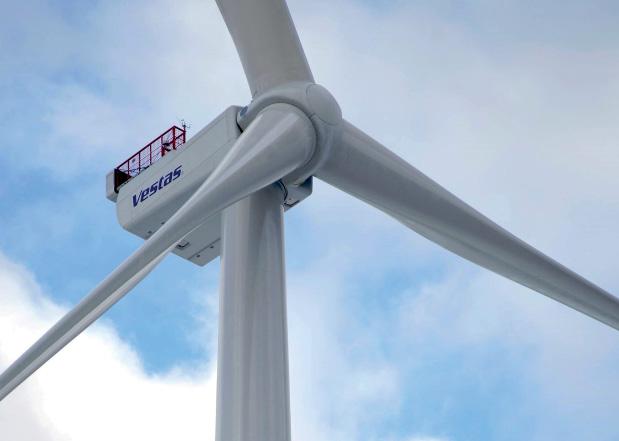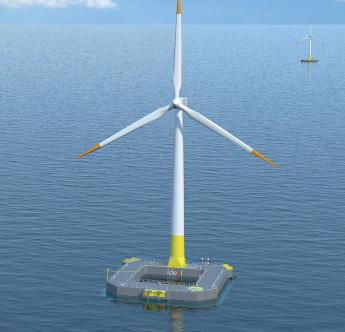
7 minute read
15mW turbines
15mW TURBINES: THE DAWN OF A NEW ERA
Danish wind turbine specialist company Vestas is developing a new wind turbine that will be the most powerful currently on off er in this fast developing market writes Dag Pike
Rated at 15mW, the company expects that it will be a ‘highly competitive unit for wind farm tenders from this year onwards. It is anticipated that the fi rst of these large turbines will be ready for trials from next year and it is anticipated that it will go into series production by 2024.
The new turbine, named V236-15MW, will have swept area of more than 43,000 sq.metres and a rotor of 236 metres in diameter and is calculated to produce around 80GWh/year, which is enough to power around 20,000 homes. Whilst the new turbine with its high rating is designed to deliver excellent performance it will reduce the number of turbines required for a wind farm which should reduce installation costs. New higher rated construction vessels may be required for the installation work but these are already under construction.
The turbine will offer a 65% higher annual energy production than the V174-9.5 MW unit from Vestas and for a 900mW offshore wind farm it will boost production by 5% with 34 fewer turbines. The new turbine is also expected to offer excellent partial-load production, which will result in more stable energy production, and a capacity factor of in excess of 60%, depending on site-specific conditions.
The president and chief executive of Vestas, Henrik Andersen said, “Introducing our new offshore platform is a huge achievement for everyone at Vestas and is a big leap forward in a very important journey. As a global renewables leader, every decision Vestas takes today must be in the service of building scale for renewables in the future - only by doing this can we ensure a more sustainable future energy system. Offshore wind will play an integral role in the growth of wind energy and the V236-15.0MW will be a driver in this development, reducing the levelised cost of energy, making our customers more competitive in offshore tenders going forward.”
Vestas said the V236-15.0 MW “will continue to harness design synergies from existing turbine platforms, such as its 9-MW unit.” It is anticipated that future upgrades will take the rating even higher.
8 V236-15MW will
have swept area of more than 43,000 sq.metres
Floating wind project sets new records
The fi rst and only off shore wind turbine installed in France has set new power generation and capacity factor records, strengthening the emerging off shore fl oating wind industry.
Ideol’s 2MW ‘Floatgen’ floating wind turbine, installed at the Sem-Rev test site off Le Croisic, produced 14% more power in 2020 than in 2019, reaching an annual total of 6.8GWh. This means the wind turbine has produced a total of 12.8GWh in two years.
“Moreover, a new capacity factor record was reached in February 2020 with more than 66%. The wind turbine faced very challenging weather conditions, with maximum wave heights of nearly 11 meters in February 2020,” said Ideol. “The excellent performance and seakeeping performance of Ideol’s patented Damping Pool technology are thus once again confirmed.”

8 Ideol’s fl oating wind technology
Photo: Ideol
THREE-YEAR DEAL SIGNED
Following these results, Ideol has confirmed its partnership with Ecole Centrale de Nantes, which operates SEM-REV, the site on which Floatgen is installed, and signed an agreement which extends the operation of the floating wind turbine by three years. These three additional years will allow Ideol to pursue its research activities in order to further optimize its solution.
Built around a European consortium of seven partners, Floatgen is being supported by the European Union as part of the FP7 programme.
Ideol has a second floating wind turbine in operation in Japan, off Kitakyushu. The company’s ‘Damping Pool’ design is claimed to be compatible with all existing offshore wind turbines.
Recent offshore wind commercial projects include a 250MW commercial farm in southern Brittany, for which a call for tenders is expected soon.
EU PROJECTS TACKLE BARRIERS TO WAVE ENERGY DEVELOPMENT
Two EU-backed projects charged with furthering the development of wave energy systems along the Atlantic seaboard are making strong progress
The projects have already recently completed a number of tasks, including the further environmental monitoring of wave energy devices off the coast of Portugal.
NON-TECHNOLOGICAL BARRIERS
The key objective of the Wave Energy in Southern Europe (WESE) and Streamlining the Assessment of Environmental Effects of Wave Energy (SafeWAVE) projects - funded through the European Maritime and Fisheries Fund (EMFF) - is to address a range of non-technological barriers that could hinder the future development of wave energy in the EU. These include those related to: environmental risk and uncertainty about the potential environmental impacts of wave energy developments, the need for a coordinated Maritime Spatial Planning (MSP) approach to overcome potential competition and conflicts between wave energy and other marine users, the lengthy and complex consenting processes, and opposition to future wave energy deployments amongst communities.
As Juan Bald, general coordinator of the WESE and SafeWAVE projects and Head of Marine and Coastal Environmental Management at AZTI, explains, this will be achieved through three different strategies. Firstly, an Environmental Research Demonstration Strategy based on the ‘collection, processing, modelling, analysis and sharing’ of environmental data collected at wave energy sites in several European countries where wave energy converters (WECs) are currently operating. Secondly, a Consenting and Planning Strategy to provide guidance to ocean energy developers and licensing authorities, as well as Decision Support Tools (DSTs) to help stakeholders obtain a suitability index for site identification and selection of future wave energy deployments for most EU countries in the ‘Atlantic Arch,’ including Portugal, Spain, France and Ireland. Thirdly, a Public Education and Engagement Strategy to work collaboratively with coastal communities in France, Ireland, Portugal and Spain and co-develop and demonstrate a framework for education and public engagement in marine renewable energy to ‘enhance ocean literacy and improve the quality of public debates.’
ONLINE TOOLS
Since the SafeWAVE project only launched is activities in October 2020, most of the activities that have been carried out so far have been under the auspices of the WESE project. Key achievements so far include monitoring of the IDOM MARMOK-A-5 device at the Biscay Marine Energy Platform (BIMEP) test site, as well as the Mutriku Wave Power Plant in Spain and the AW Energy WaveRoller device in Peniche, Portugal.
In other developments, the MARENDATA online data platform for the sharing of environmental data has been developed and launched, a stakeholder database and review of the consenting processes in Spain and Portugal has been completed. Two open-access web-based applications - the WECERA (Wave Energy Converters Ecological Risk Assessment) and the VAPEM (Ecological Assessment and Marine Spatial Planning) tools have also been launched.
Looking ahead, Bald reveals that the WESE team will spend the rest of this year translating the experience and lessons learned during the various monitoring programmes into guidelines and modelling activities that enable stakeholders across the wave energy sector to better understand what he describes as ‘the potential cumulative pressures and environmental impacts of future WE deployments at larger scale.’
“All this information will be shared in the MARENDATA data platform. Based on the results of previous tasks, guidance will also be developed for Spain and Portugal aimed at describing the various steps of the licensing process of WE projects to be located in the continental coast,” he says.
“Suitability maps for WE deployment in Spain and Portugal will also be created thanks to the DSTs of MSP that have been developed. All the results will be presented in a final event. The place and dates of this final event is still under discussion due to the COVID crisis but we will try to do it in the framework of the EWTEC21 conference in September 2021,” he adds.
Meanwhile, the SafeWAVE project, which runs from 20202023, will ‘take up the baton of the WESE project’ and continue the activities of the earlier initiative - extending its field of action to France and Ireland, as well as to new wave energy technologies, more advanced monitoring methodologies and new activities focused on the development of a Public Education and Engagement Strategy.


8 CTD seacast
device deployed for acoustic monitoring at BIMEP. Inset: ROV for seafl oor monitoring at BIMEP
Co-located with:
M&CCE Expo is open for business all year
The Marine & Coastal Civil Engineering (M&CCE) Expo is Europe’s leading event dedicated to showcasing the latest equipment and solutions for marine, coastal and other challenging civil engineering projects with unique landscape features.

Reach a larger audience than ever before
M&CCE Expo will be co-located with Seawork, Europe’s leading commercial marine and workboat exhibition.
Reserve now for 2021. Make the most of marketing support from
M&CCE, Seawork and our leading commercial marine magazines, in print, online, eNews and via social media.


For more information visit: mcceexpo.com contact: +44 1329 825335 or email: info@mcceexpo.com
Organised by:
Media partners: Supported by:





